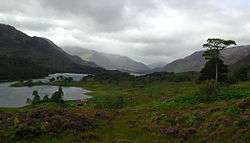Loch Affric
Loch Affric is a freshwater loch within Glen Affric, in the Highland council area of Scotland. It lies about 25 miles (40 km) southwest of Beauly.[1][2] The loch sits in a national nature reserve known for being home to a number of rare species and the loch itself is popular for trout fishing.[3][4] An annual duathlon is held on the banks of the loch in May and the loch has been widely used as the backdrop in films.[5][6]
| Loch Affric | |
|---|---|
 Looking west over Loch Affric | |
| Location | Inverness-shire, Highland (council area), Scotland |
| Coordinates | 57°15′14.267″N 5°3′23.429″W |
| Primary outflows | River Affric |
| Basin countries | Scotland |
| Max. length | 5 km (3.1 mi) |
| Surface area | 2.13 km2 (0.82 sq mi) |
| Average depth | 29 m (94 ft) |
| Max. depth | 67.4 m (221.1 ft) |
| Water volume | 6.06 km3 (1.45 cu mi) |
| Surface elevation | 235 m (771 ft) |
Geography
Loch Affric is one of two large lochs within Glen Affric, further up the glen to the southwest of Loch Beinn a' Mheadhoin. The River Affric is the main inflow and outflow for both lochs.[2]
A number of smaller lochs surround Loch Affric. At the southwestern end sits Loch Coulavie located at the base An Tudair Beag and a slightly higher elevation. Also at the south western end, the River Affric flows into the tiny loch of Loch na Camaig. At the north eastern side, Loch Pollan Fearna drains into Loch Affric.[2]
Much of the area around the loch is mountainous. To the north, is Sgùrr na Lapaich (1,074 m, 3,524 ft) and An Tudair (1,036 m, 3,399 ft), outlying Munro Tops of Mam Sodhail. To the south lie the Corbetts of Aonach Shasuinn (888 m, 2,913 ft) and Carn a' Choire Ghairbh (865 m, 2,838 ft).[2]
Botany & wildlife
The loch sits within the Glen Affric national nature reserve,[7] the banks of the loch are made up of woodland with a mixture of Scots pine, silver birch, and other pine trees.[3] Wildlife, which is rare in Great Britain noted to live in the nature reserve includes pine marten, Scottish wildcat, otter, red squirrel and golden eagle.[8] The Scottish crossbill is also known to live in significant numbers in the Scots pine on the shores of Loch Affric.[9] Rare dragonfly are noted to be frequently seen near the shores of Loch Affric. These include azure hawker, downy emerald, brilliant emerald, northern emerald and white-faced darter.[4]
Loch Affric is home to brown trout with fishermen reporting an average weight of a catch at 8 ounces (230 g) up to around fish weighing 5 pounds (2.3 kg). During an average fishing season around 1,000 trout are caught on the loch. Fishing is restricted to boat fishing only with permission controlled by the nearby Glen Affric Lodge.[10]
Hydro-electric development
In 1929 the building of a hydroelectric dam by the Grampian electricity supply company on Loch Affric was considered.[11] However, following public fallout regarding some schemes developed in the preceding decade in Perthshire changes were made by the board to the original scheme to flood Glen Affric. Instead of damming Loch Affric, the nearby Loch Benevean would be dammed by the North of Scotland Hydro-Electric Board in the late 1940s resulting in a level rise of only twenty-five feet (7.6 m) and only one residential property would be lost. In turn the process of building the dam was reported to create around two-thousand jobs.[12]
Film
Loch Affric has been used as a recording location for a number of Hollywood films. These include Victoria & Abdul (2017),[13] Detective Pikachu (2019),[14] Dog Soldiers (2002) and Valhalla Rising (2009).[6]
References
- Ordnance Survey 1:50,000 scale Landranger map sheet 25 Inverness
- Ordnance Survey 1:25,000 scale Explorer map sheet 414 and 415
- "Dog Falls - Forestry and Land Scotland". forestryandland.gov.scot. Retrieved 2020-03-04.
- Smallshire, David; Swash, Andy (22 May 2014). Britain's dragonflies : a field guide to the damselflies and dragonflies of Britain and Ireland (Third ed.). Princeton. ISBN 978-1-4008-5186-7. OCLC 878405974.
- "Glen Affric Duathlon receives inspirational award". Inverness Courier. 2019-11-28. Retrieved 2020-03-04.
- "TV & Filming Locations in Scotland". www.visitscotland.com. Retrieved 2020-03-04.
- "Search by A-Z | Scotland's National Nature Reserves". www.nnr.scot. Retrieved 2020-03-04.
- Wilson, Neil; Symington, Andy (April 2017). Scotland (9th ed.). Footscray, Victoria. ISBN 978-1-78701-033-8. OCLC 988325503.
- Uney, Graham (2006). Backpacker's Britain. Volume three, Northern Scotland - the Higlands and islands (First ed.). Milnthorpe, Cumbria. ISBN 978-1-84965-793-8. OCLC 898150992.
- Sandison, Bruce (2011). Rivers & lochs of Scotland : the angler's complete guide. Edinburgh: Black & White Publishing. ISBN 978-1-84502-520-5. OCLC 811489952.
- Payne, Peter Lester (1988). The hydro : a study of the development of the major hydro-electric schemes undertaken by the North of Scotland Hydro-Electric Board. Aberdeen, Scotland: Aberdeen University Press. ISBN 0-08-036584-1. OCLC 27013708.
- Miller, Jim. (2012). The Dam Builders : Power from the Glens. Edinburgh: Birlinn. ISBN 978-0-85790-563-5. OCLC 817880647.
- Now, Scotland (2017-11-02). "Six of 2017's most stunning movie locations in Scotland". dailyrecord. Retrieved 2020-03-04.
- "Pokemon film scenes shot in Highlands". BBC News. 2018-11-14. Retrieved 2020-03-04.
| Wikimedia Commons has media related to Loch Affric. |